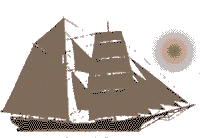NAPARIMA COLLEGE
FOREVER
Notes on the Canadian Mission to Trinidad, X
Highlights of the Pioneer Adventure:
The Aurora, and the Transport of the Times
The Canadian Mission to the East Indians of Trinidad began with a casual voyage to the British West Indies by Rev. John Morton aboard the small brigantine MicMac, captained by Robert Dawson, out of Bridgewater, Nova Scotia, in November 1864. The MicMac stopped at Bridgetown, Barbados, for here was located a firm which brokered the needs of the West Indian Islands to North American and European suppliers, and here the captain of the MicMac learned that a buyer in Trinidad would pay best prices for the oak staves it had on board. Thus came about Dr. Morton's first visit to Trinidad, where he stayed for four months. The visit made such a formative and momentous impression on him that he arranged his return voyage on an American ship to Philadelphia, so that he could discuss a prospective mission (unsuccessfully) with the Presbyterian church there . Upon return to Nova Scotia, over the next two years Dr. Morton secured backing for his Mission from his own presbytery. As the sole pioneer missionary to the East Indians of Trinidad, he embarked for the island aboard the brigantine Aurora out of Bridgewater, Nova Scotia on November 1868, arriving at Port of Spain after a stormy and violent passage on January 8, 1869. The captain of the small vessel gave up the only cabin on board for his passenger, and the latter's wife and small child. The back-bone of the North American north-south sailing-ship trade in the 19th century was the small sailing-ship, 100 ft or less in length, manned by six to eight sailors, built quickly and at a relatively low cost. The operational rate of loss was high - perhaps 25% or more within a 5-year period.The brigantine Aurora (107.6 x 27 x 12.7 ft, 227 tons) was built in La Have (Bridgewater) for Andrew Gow and Ephraim Hebb, (elders of the Bridgewater Presbyterian church, so Rev. Morton's passage was contributed), and registered (#42515 Nova Scotia Registry of Shipping, 1866) in the nearby lively port of Lunenburg in 1863. She was destroyed by fire in New York harbour on November 29, 1868, less than a year after Rev. Morton's momentous and eventful passage. |  ... a brigantine |